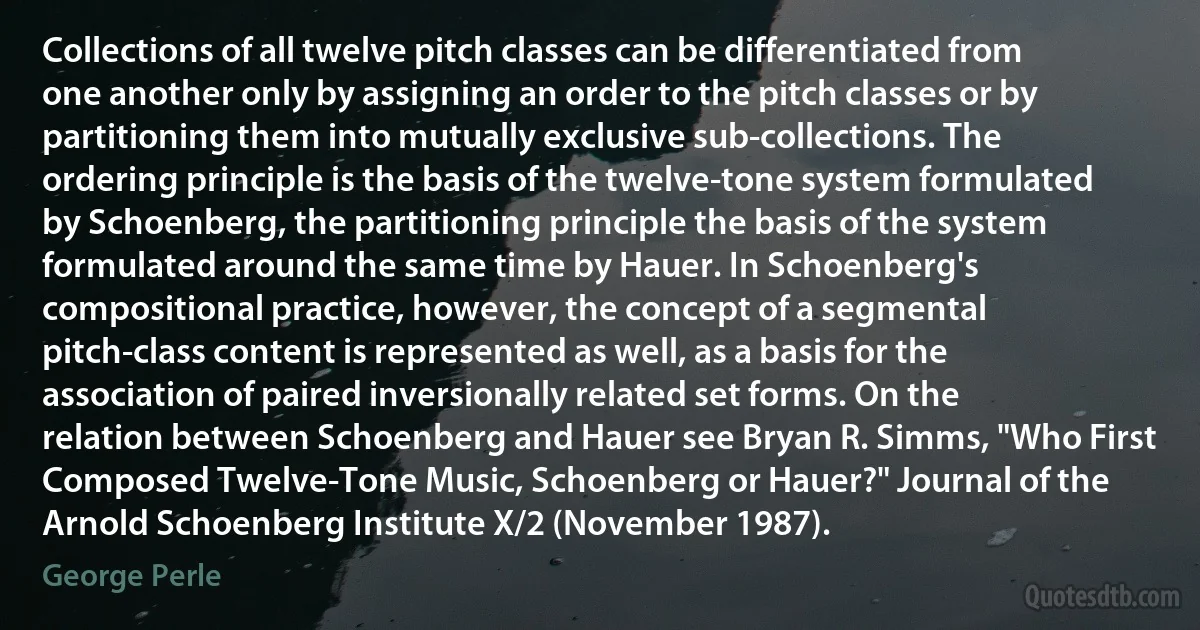
Collections of all twelve pitch classes can be differentiated from one another only by assigning an order to the pitch classes or by partitioning them into mutually exclusive sub-collections. The ordering principle is the basis of the twelve-tone system formulated by Schoenberg, the partitioning principle the basis of the system formulated around the same time by Hauer. In Schoenberg's compositional practice, however, the concept of a segmental pitch-class content is represented as well, as a basis for the association of paired inversionally related set forms. On the relation between Schoenberg and Hauer see Bryan R. Simms, "Who First Composed Twelve-Tone Music, Schoenberg or Hauer?" Journal of the Arnold Schoenberg Institute X/2 (November 1987).
George PerleRelated topics
assigning association basis concept content exclusive institute journal music november order ordering partitioning pitch practice principle relation see set system time twelve well arnold schoenberg bryanRelated quotes
The spurious axioms of the third kind from conditions proper to the subject whence they are transferred rashly to the object are plentiful, not, as in those of the Second Class, because the only way to the intellectual concept lies through the sensuous data, but because only by aid of the latter can the concept be applied to that which is given by experience, that is, can we know whether something is contained under a certain intellectual concept or not. To this class belongs the threadbare one of the schools: whatever exists contingently does at some time not exist. This spurious principle springs from the poverty of the intellect, having insight frequently into the nominal, rarely into the real, marks of contingency or necessity.

Immanuel Kant
In ourselves alone the absolute light keeps shining, a sigillum falsi et sui, mortis et vitae aeternae [false signal and signal of eternal life and death itself], and the fantastic move to it begins: to the external interpretation of the daydream, the cosmic manipulation of a concept that is utopian in principle. Finding this concept, finding the right for whose sake it behoves us to live, to be organized, to have time-this is where we are headed, why we are clearing the metaphysically constitutive trails afresh, calling for what is not, building into the blue that lines all edges of the world; this is why we build ourselves into the blue and search for truth and reality where mere factuality vanishes.

Ernst Bloch
Let us get down to fundamentals. Is this an open, or is this a closed society? Is it a society where men can preach ideas - novel, unorthodox, heresies, to established churches and established governments - where there is a constant contest for men's hearts and minds on the basis of what is right, of what is just, of what is in the national interests, or is it a closed society where the mass media - the newspapers, the journals, publications, TV, radio - either bound by sound or by sight, or both sound and sight, men's minds are fed with a constant drone of sycophantic support for a particular orthodox political philosophy? I am talking of the principle of the open society, the open debate, ideas, not intimidation, persuasion not coercion...

Lee Kuan Yew
It is also the becoming-space of the spoken chain - which has been called temporal or linear; a becoming-space which makes possible both writing and every correspondence between speech and writing, every passage from one to the other.
The activity or productivity connoted by the a of différance refers to the generative movement in the play of differences. The latter are neither fallen from the sky nor inscribed once and for all in a closed system, a static structure that a synchronic and taxonomic operation could exhaust. Differences are the effects of transformations, and from this vantage the theme of différance is incompatible with the static, synchronic, taxonomic, ahistoric motifs in the concept of structure.

Jacques Derrida
The attitude of Aristotelian physics toward lawfulness takes a new direction. So long as lawfulness remained limited to such processes as occurred repeatedly in the same way, it is evident, not only that the young physics still lacked the courage to extend the principle to all physical phenomena, but also that the concept of lawfulness still had a fundamentally historic, a temporally particular, significance. Stress was laid not upon the "general validity” which modem physics understands by lawfulness, but upon the events in the historically given world which displayed the required stability. The highest degree of lawfulness, beyond mere frequency, was characterized by the idea of the always eternal.

Kurt Lewin
